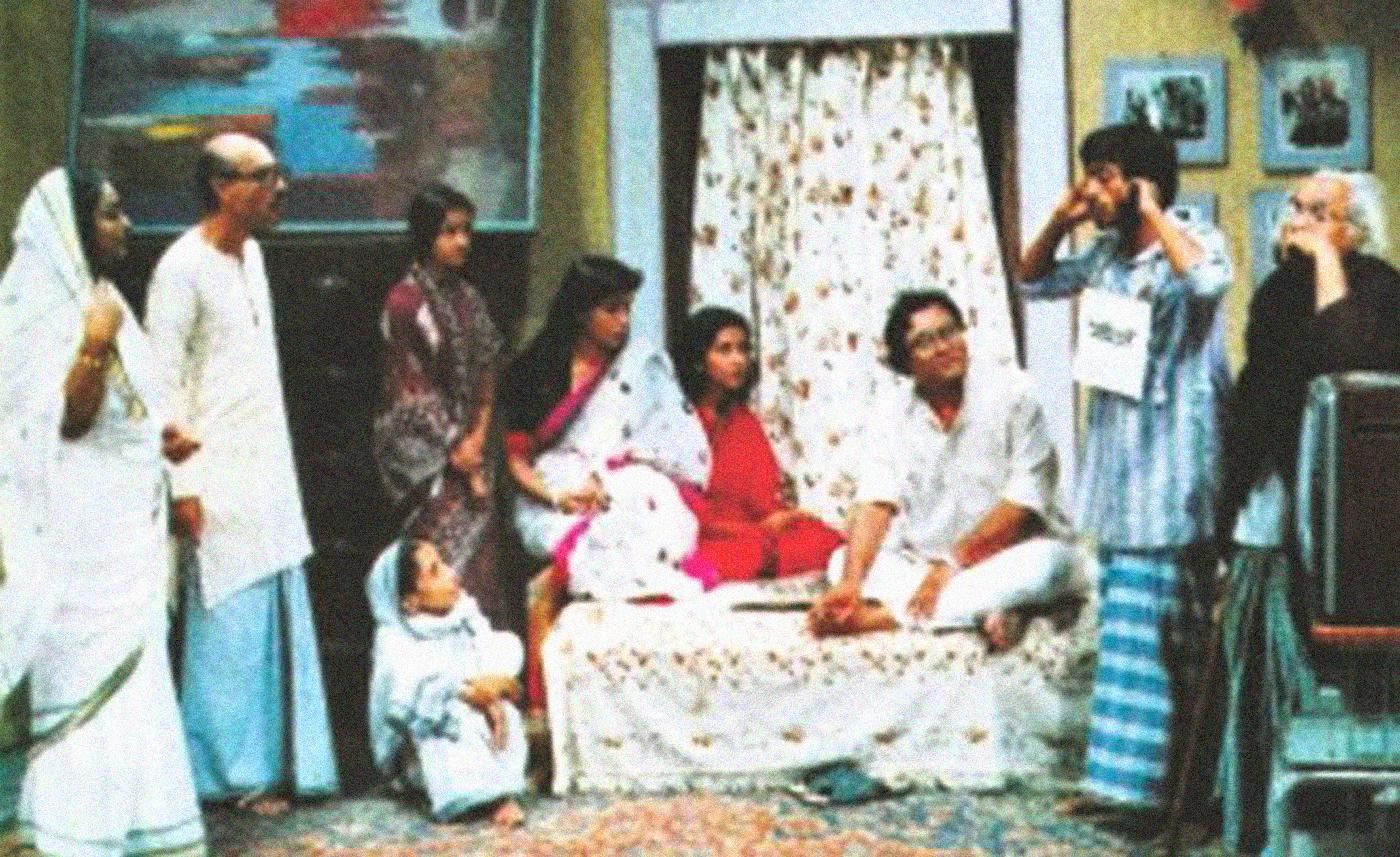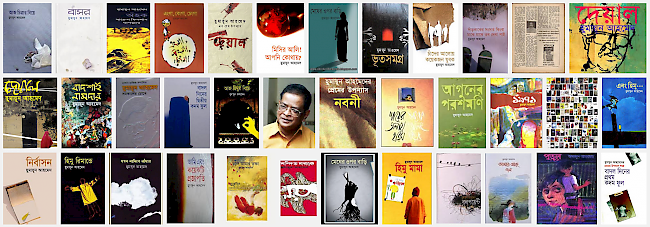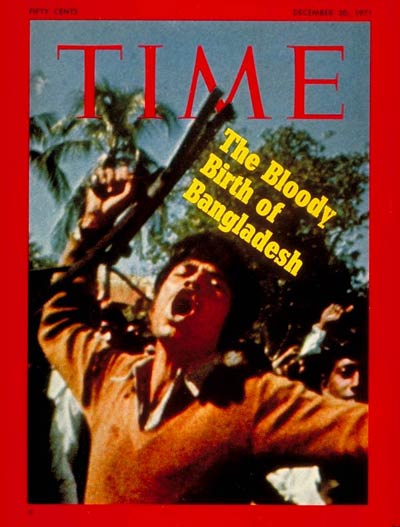— Traitors, a Mutable Lexicon

In the 1980s, television in Dhaka was a sterile broadcast box. There was one government channel (Bangladesh Television), starting at six in the evening and ending at midnight with a fluttering flag over Tagore’s national anthem. Programming formats were prescribed, and even to sing on one of the variety shows, you had to pass an exam to become a “registered artist.” The nightly English-language program was usually a “remaindered” show on delayed recycling routes (High Chaparral and The Wild Wild West on a twenty-year time lag). This tedium of evening viewing finally cracked open with the inauguration of best-selling novelist Humayun Ahmed as a television dramatist.

Ahmed was the most successful novelist of postindependence Bangladesh, tapping into a new appetite for stories about the city’s middle class—as opposed to the staple of a romanticized, idyllic village life that perhaps never existed. Following his literary success, Ahmed began to write serialized plays for television. One of his most popular characters was a naming device in the figure of a talking parrot. In the inaugural episode, the bird was being trained to say “Tui Razakar!” (You are a wartime collaborator):
Mrs. Shah: Are they dead?
Peon: How could they not die? Listening to that one tape recording [of “Tui Razakar!”] all day, their brains are out.
Mrs. Shah: Aha …
Peon: One is still alive, just dozing.
Mrs. Shah: He hasn’t learned any of the words?
Peon: A child takes two years to learn to speak, and this is only a bird!
Khalil (entering): Project abandoned. Where did he get these donkey birds? All that effort gone to waste … Mrs. Shah, actually, a bird is a hollow fruit. Pretty on the outside, nothing inside.
Dulabhai (comes near the bird): Is this the bird?
Bird (screaming): Tui Razakar! Tui Razakar! Tui Razakar! Tui Razakar!
Dulabhai: That … that … donkey has taught him this word? Of all the things to teach? Get it out of here!
Bird: Tui Razakar! Tui Razakar! Tui Razakar! Tui Razakar!1Humayun Ahmed, Bohubrihi [Multiple dimensions], BTV, 1988. See also →
In that onscreen family tableau, there was often a new arrival (“agontuk”) who was an unwelcome intruder. Each time he would enter the stage, the parrot would scream “Tui Razakar,” prompting gales of amusement from the TV audience. Fans applauded Ahmed for popularizing the naming and shaming of traitors. A hit character and a blockbuster show were born in this moment, as was a conflating of “war collaborator” with the generic tele-villain. A talking parrot is a familiar device, moving many stories along—eyewitness to murder in the Tintin comic series (The Broken Ear), and repeater of Holocaust numerals in Michael Chabon’s The Final Solution. But a parrot is also embedded in popular media as an unthinking mimic. Once trained, it can and will call anything and everything “Razakar.” And here our troubles begin.

A Short War With a Long Reckoning
The 1971 war that split apart Pakistan and created Bangladesh (the former East Pakistan) was the final chapter in a long unraveling of borders starting in 1905 (the British partition of Bengal), continuing in 1947 (the partition of India), and finally accelerating to the finale of 1971. The war’s end was marked by strong Indian intervention, both in the battlefield and in a faceoff at the United Nations. The unexpectedly quick ending to the war spawned a series of problems around questions of loyalty to the new country. Approximately ten million had become refugees during the war in India. Many had joined the guerrilla army and fought the Pakistan army directly. However, what of the millions who had stayed in Bangladesh, continuing to work? The new government understood that if all the people who had stayed in the civil service and universities during 1971 were identified as traitors, the fragile new country would be paralyzed. But the list-makers were equally determined to exhaustively name “collaborators,” “Pakistan lovers,” and the “jatiyo shotru” (national enemy). This crisis became so acute that journalist Enayetullah Khan wrote an editorial provocatively titled “Sixty-Five Million Collaborators” (sixty-five million was the size of the population that stayed back during the war).2Enayetullah Khan, “Sixty-Five Million Collaborators,” The Weekly Holiday (February 6, 1972).
In the polarized context of 1972, one group of intellectuals demanded a complete “shuddhikoron obhijan” (cleansing expedition) among their ranks. Others, like Khan, insisted that a nuanced view was needed so as not to devolve into a settling of scores. The language being used to describe individuals became crucial. There were two sets of terms that were common: “muktijoddha” and “birangona” for war veterans, and “Razakar,” “ghatak,” and “dalal” for accused collaborators. People who had taken up arms during the war were muktijoddha (liberation warriors) or mukti, while victims of rape during the war were birangona (heroic women). The language for naming traitors was taken from the “fifth column” itself, when it formed a paramilitary group called “Razakar” to support the Pakistan army during the war. The first contemporary political use of this term was during the 1947 Indian partition, when the Nizam of Hyderabad formed a volunteer corps called “Razakar” to resist the Indian army’s entry into his kingdom for annexation. Since the 1971 war was presented in Pakistani media as the “interference” of India and “disloyal Hindus” in East Pakistan, the idea of resurrecting the Razakars who fought against Indian annexation was resonant.
As the war came to a close, the Razakar paramilitaries carried out death-squad operations targeting Bangladeshi university professors and noted public intellectuals. After the surrender of the Pakistan army, the movement collapsed and Razakar members went into hiding or exile. Because Pakistani soldiers were handed over to Indian custody (and later returned to Pakistan as part of a prisoner swap), postwar anger focused on the collaborators. The work of accusation played out while the country’s institutions were in shambles. In the absence of a strong central government, the accusatory regime expanded its definitions of betrayal to include many of those who had stayed in the country during the war. This group was potentially very large, but the term “Razakar”—linked to a formal paramilitary—could not be applied to them. New distinctions were erected: active service in death squads, verbal support for the regime, or passive support by continuing to work during the war. To address these new layers, two more terms came into popular use: ghatak (killer) and dalal (stooge).

… To Let You Know That We Are Not Dead
Informal lists of collaborators were in existence throughout the 1970s, but the current understanding of “collaborators” was granulated in 1987, in a book published by the Muktijuddha Chetona Bikash Kendra (Center for Expressing the Spirit of the War of Liberation). The book’s title omitted the word “Razakar,” instead using the phrase Ekatturer Ghatak o Dalalra Ke Kothay? (Where are the killers and stooges of 1971?). In the foreword to the first edition, the editorial board wrote:
We have said many times before, and will say again, we do not need a list of freedom fighters. Such a list is impossible anyway, because at that time seventy million people were freedom fighters in their heart and body. What we need lists of are the small minority of killers and stooges, so that the people can be alert about them, and prevent their rehabilitation.3Ekatturer Ghatak o Dalalra Ke Kothay? [Where are the killers and stooges of 1971?], ed. Ahmad Sharif, Quazi Nur-Ujjaman, and Shahriar Kabir (Dhaka: Muktijuddha Chetona Bikash Kendra, 1987), 6–7.
The second volume concatenated the two terms into a hyphenated one: Ekatturer Ghatak-Dalal ja Boleche ja Koreche (The killer-stooges of 1971: what they said, what they did). Both volumes started with lists of members of the paramilitary, reserving the secondary term of dalal for those indicted based on the action of staying in their jobs, or statements they made during the war.
I have been particularly intrigued by one strange document in the first volume. This is a statement signed by “fifty-five intellectuals” clarifying that they were “not dead”:
The International Committee of University Emergency in New York has released a statement saying “Mass killing of intellectuals in Dacca.” We the university professors, college teachers, authors, journalists, and artists appreciate ICUE’s concern for our safety, well-being, and future … We have been shocked to see our names on the list of people wounded and killed. We have no choice but to let you know that we are not dead.
The fifty-five signatories included many prominent Bengali cultural figures, including scholar Munir Chowdhury, philosopher Sardar Fazlul Karim, film director Khan Ataur Rahman, actor Fateh Lohani, poet Ahsan Habib, singer Sabina Yasmin, and my grandfather, historian Syed Murtaza Ali. The statement is rambling, and much of it reads as if edited by committee (or dictated by Pakistani officials). After the war, this statement was circulated with demands to blacklist each person on this list. The response from these intellectuals and their defenders was that the statement was signed under duress and could not be evidence of guilt. Enayetullah Khan again led the defense, highlighting that one signatory was later killed by the Pakistan army:
Bangladesh, during the nine months of occupation, was like a vast concentration camp where government officers and employees, teachers of schools and colleges, industrial workers and artisans, intellectuals and artistes were compelled to go on forced labour like slaves in chains … Let us cite some instances to drive some sense into the head of the zealous patriots—the glorified refugees who fled this country. Sardar Fazlul Karim who was forced to sign the statement of 64 intellectuals singing hymn for the regime was taken into custody by the same regime. Munir Chowdhury, a signatory, was deemed to be too dangerous by the collaborators of Yahya to be kept alive. This does not mean that all the rest of the signatories come under the same category. But there must be many more people like the above-mentioned ones whose patriotism should not be questioned merely on the basis of an isolated action situation and certainly the past 24 years.4Khan, “Sixty-Five Million Collaborators.”
The role of India as a supporter of the Bengali guerrilla army made some signatories uneasy, and there are backhanded references in the document to intellectuals who fled to India to get “high salary” jobs at universities there. Some of the people who signed might have felt loyalty to the idea of a united Pakistan, in spite of voting for regional autonomy in the 1970 elections. One part of the statement indicates wavering political self-realization:
We have our own complaints against the Pakistan regime and we expressed that by voting for the regional autonomy of East Pakistan in the national elections … Bengali Hindus, [and] the Marwaris of Calcutta, oppressed us in the past and that is why the Bengali Muslims first decided to create a separate province in 1905 under the British, and again we took the conscious decision by referendum to join the Muslim brothers of other provinces of Pakistan in 1947. We have no reason to regret that decision.5Quoted in Sharif et al., Ekatturer Ghatak o Dalalra Ke Kothay?, 142–144. The original Bengali text of the letter uses the incorrect phrase “Bengali Hindus, especially the Marwaris of Calcutta.” “Marwari” was originally used to describe migrants from Marwar, Rajasthan, who were the trading class of British Calcutta. Over time, it became a slur for communities of businessmen and moneylenders who were considered to be miserly and carpetbaggers. Since the category is not specific to Bengalis, conflating the two terms with “especially” may indicate that this letter was originally drafted by someone not completely familiar with Bengali communities, i.e., possibly an Urdu-speaking administrator from West Pakistan.
How were people to determine who was coerced into signing, and which parts of the statement they agreed with? With so many leading cultural figures indicted by one document, after the war an inquiry commission was formed to investigate, led by feminist scholar Nilima Ibrahim. The committee’s report highlighted the discrepancies in the document (e.g., signatures in English and Bengali, the same name printed multiple times, signatures taken on a blank paper). The committee’s findings were not made public, but the contents were leaked to a magazine. In response, many of the signatories issued statements clarifying why they had signed, with Khan Ataur Rahman’s defense being the most common: “I signed to stay alive, or, [to quote from a song,] ‘Morite chahi na ami sundor bhubone’ [I do not wish to die in this beautiful world].’”6Ibid., 157. Another form of exoneration came from a sympathetic reading of the signatories’ total literary output. The Ghatak-Dalal book editors were therefore willing to give the benefit of the doubt to signatories such as Sardar Fazlul Karim (“his role in the progressive movement”) and Ahsan Habib (“on the side of progressives”) based on their prewar publications. Syed Murtaza Ali in particular was exonerated by a filial bond and a career wound. His younger brother, the more popular author Syed Mujtaba Ali, was one of the first to demand that Bengali (instead of “Islamic” Urdu) be made the state language of East Pakistan (“Pakistan’s state language: Bengali or Urdu?,” Tamuddun Majlis, September 15, 1947). This language activism infuriated the Pakistani government, but they were unable to touch Mujtaba as he spent most of his time in Calcutta, India. Therefore, reprisal by proxy was taken by slowing down the civil service career of Murtaza, and this is what protected him from any questions of loyalty after 1971. Indeed, Murtaza eventually became President of the Bangla Academy, the institute tasked with centering Bengali language in national culture in order to roll back the damage of the Pakistan years.

What Do You Really Want to Say?
The close reading of this one statement by the Ibrahim committee recalls Philip Watts’s description of the post-1945 purge of alleged Vichy collaborators from French literature.7Philip Watts, Allegories of the Purge (Stanford: Stanford University Press, 1998). Literary critics in France struggled between an insistence on the responsibility of the author, and the contrarian insistence on the right to ambiguity and multiple readings. The Bangladeshi literary establishment, in contrast, insisted on the absolute clarity of the so-called real. In France, the idea of les responables who were accountable for prises de position (Bourdieu’s “position taking”) rippled powerfully through literature. Jean Bruller (Vercors) insisted that published writing was an intellectual act, and that the writer must be held responsible for its consequences. Simone de Beauvoir made the idea of responsibility the defining element of modern man. Céline, on the other hand, defending his own writing, insisted that these were simply books, nothing else—that literature was without consequence. Although his defense was seen as self-serving, Marguerite Duras found more sympathetic readers when she argued for the idea of pure literature. In response to revelations about Paul de Man’s writing for a collaborationist newspaper, Derrida asked to defer the idea of responsibility by defining its focus. Unlike Sartre’s idea of literature as a transparent and univocal signifying system (in What Is Literature?), Derrida insisted there were always ruptures and equivocations in the text, and that responsibility was transferred from the author to the reader.
Derrida had a few readers in Bangladesh, but his argument could not gain traction in a purge environment. The motif of cleansing operations was the phrase “Apni ashole ki bolte chan?” (What do you actually want to say?). There was to be no transference of responsibility to the reader, or the possibility of multiple readings. Invoking Lewis Carroll’s Humpty Dumpty, things were to be exactly what the list-makers said the author had said, not one word less. Storylines that presented freedom fighters as less than heroic, or that played with illegibility, came under attack. Mahmudul Haque’s 1973 novel Jibon Amar Bon (My sister, life) presented a protagonist who stayed aloof from the movement, and paid a terrible price at the end.8The title is an homage to Pasternak’s poem. For analysis of this novel, see Shabnam Nadiya, “Jibon Amar Bon,” Translation Review 80.1 (2010): 134–135. Mahmud Rahman provided information on the reception of Haque and Akhtar’s novels. Readers critiqued the ambiguous antihero, and some sought a parallel with Haque’s own decision to stay in Bangladesh during the war. Published thirty years later, Shaheen Akhtar’s Talash (The search) was feted but also faced some discomfort for its ambiguous wartime figures. Experiments with inserting Urdu (seen as the language of the Pakistan project) into Bengali literature also rankled many, including feminist author Taslima Nasreen, who argued for “purity” in poetry:
The other day I asked poet Shamsur Rahman—Why are there so many Urdu words in your poetry?
Shamsur Rahman replied—Those words are used.
I said—Most of these words I don’t know. And yet you say they are used. Or is it that they sound used to you because your wife is an Urdu speaker, and Urdu is spoken in your home?
Shamsur Rahman smiled gently and said—She speaks Bengali now.
I said—Or are you trying to create an Islamic Bengali language that is separate from the language of West Bengal?
… Shamsur Rahman said—No, that is not it. There are Bengali words. But what is the harm if new words come into a language? The language becomes richer.
I cannot accept this logic of Shamsur Rahman. The Bengali language is not such a beggar that it has to steal or borrow from others.9Taslima Nasreen, Jabo Na Keno? Jabo [Why won’t I go? I will go] (Dhaka: Kakali Prakashani, 1992).
Whatever the explanations given for wartime conduct (the Ibrahim committee report generated many possibilities), names continued to be tallied for formal blacklists and shadowy boycotts. There were also politicians on the lists, but cultural and academic figures suffered the most from being identified as dalal (they were always called “stooges,” but nobody went as far as to call them ghatak, or “killers”). In their sphere of work (newspapers, universities, theater, publishing), the stigma of whispers had a corrosive effect over forty years, and has proven impossible to rectify through political negotiation. “Razakar” was also freely used in place of “stooge,” gradually becoming—in the mouths of both parrots and people, loudly and in whispers—a ubiquitous word for all forms of betrayal. As the years progressed, the figure of the “traitor” solidified through literature, film, and television. The “betrayer” was sometimes identified by behavior, sometimes by religious garb, and often by something as banal as the accusation of a talking parrot. Humayun Ahmed’s TV series was called Bohubrihi, which translates as “multiple dimensions.” But the traitor-naming action he signaled foreclosed multiple possibilities, dividing wartime behavior into strict binaries. In this process, certain preferences were often stigmatized in broad strokes (e.g., “Islamic-minded,” “Urdu-lover”). The casualty of these prolonged periods of shuddhikoron (purification) and kharijikoron (negating) has been the possibilities of textual ambiguity, illegibility, and contradiction. The death of the author came, ironically, through this insistence on a singular reading.
×
The author thanks Udayan Chattopadhyay, Rosalind Morris, Shafiq Rahman, and Mahmud Rahman.


